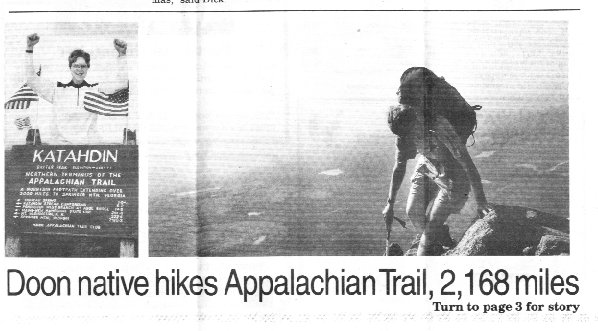An article on Samwise's AT Thru-Hike appeared in the November 29 issue of the Doon Press.

Following is the article as it appeared in the Doon Press. The Photo was on the front page ("below the fold") and directed the reader to the article on page 3 inside.
Doon, Ia was Samwise's hometown for much of the first 18 years of her life.
Appalachian Trail Thru-Hike 2001
Former Doon native Julie (Kelderman) Crawford spent the past six months walking from Georgia to Maine. On October 4, the long-distance hiker completed the 2,168-mile Appalachian Trail by climbing its final peak in Maine, Mt. Katahdin.
The Appalachian Trail (AT) is a wilderness footpath, running along the ridgecrests of the eastern Appalachian mountains from Georgia to Maine. For more than 50 years, hikers have taken on the challenge of completing the entire trail in one year, thereby becoming “thru-hikers.”
Crawford began her journey on April 1 from Springer Mountain, Georgia. Once conditioned, she usually hiked for 10 or 12 hours a day, covering an average of 12 - 15 miles. On flatter sections of the trail, 20+ mile days were normal, with her personal mileage record reaching 26 miles.
She carried an average of 40 pounds in her backpack, and slept in the wilderness nearly every night for 187 days, either in a tent or in a shelter. Shelters are primitive, 3-sided wooden lean-tos, built along the AT every 10 to 20 miles, and sleeping from 5 to 10 hikers side by side on the floor.
Approximately once a week, Crawford was able to reach a town near the trail, where she could usually do laundry, take a shower, use the telephone and pick up supplies sent by her husband. With a diet heavy in chocolate, home-made energy bars and high-fat trail mix, she ate 4,000 - 5,000 calories per day, to keep up with the rate that her body was burning calories.
Loneliness, body aches and injuries, and steep terrain are all difficulties of hiking the AT, but “the hardest part of the journey was being away from my husband,” Crawford admitted. Her husband, Tony, served as “home base” for the trip, sending food and supplies and taking care of bills at their home in Alexandria, Virginia.
The 6-month hike in the wilderness allowed Crawford to experience a wide variety of weather conditions, animal encounters and beautiful scenery. She hiked through snow in Georgia, endured almost three weeks of solid rain in Virginia and sweated through a record- setting heat wave in New England, often forced to carry up to a gallon of water at a time because of the drought.
Near water sources is where she often enjoyed seeing animals, including white-tailed deer, snowshoe hares, black bears, ground hogs, snakes, loons and moose.
"Each state has its own beauty,” she insists, “but I believe Maine has the most gorgeous scenery.” One of Maine’s gems is the “100-mile Wilderness,” the most remote section of the AT. Hikers also experience its delicate alpine bogs, dozens of mountain peaks above treeline, and hundreds of clear mountain ponds, lakes, and streams. Not only is Maine quoted as the most scenic trail state, it also enjoys its status as the most difficult. The so-called “hardest mile of the trail” is the Mahoosuc Notch in southern Maine. The Notch is a boulder field, left by retreating glaciers of long ago. Hikers must clamber over, crawl under and straddle crevasses between the car and house-sized boulders for 2 to 3 hours to get through the one mile.
The AT goes through 14 states and it is maintained by hundreds of volunteers who are members of various trail clubs. The total elevation gained from climbing up (and down) so many mountains is the equivalent of hiking Mt. Everest from sea level to its peak 16 times.
Among National Scenic Trails, the AT is the oldest and most popular, attracting 2,000 - 3,000 hikers to its southern terminus each spring. Approximately 10 percent of these hikers are able to complete the entire trail, the rest succumbing to injury, homesickness, or lack of funds to finish the trail.
When asked how an Iowa farm girl came to love the mountains so much, Crawford grins, “It’s all my parents fault. Each summer when I was a kid, they took us to Colorado for camping trips in the Rocky Mountains. I’ve been hooked ever since.”
